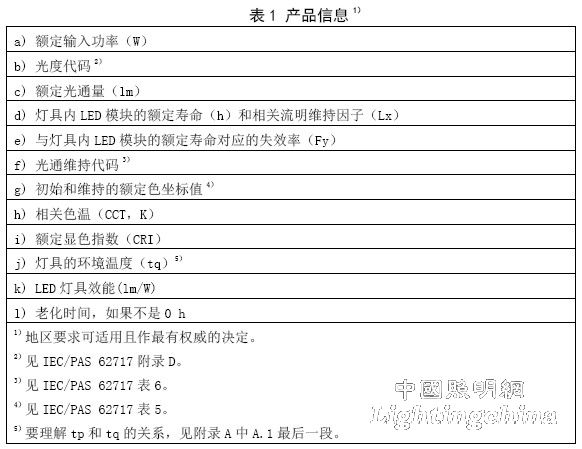The IEC/PAS specification for LED luminaire performance has progressed since the Helsinki meeting in Finland in June 2010 and the Seattle meeting in October 2010. The standard number has been given IEC/PAS62722-1 "Lamp Performance - Part 1: General requirements". The related LED module performance and LED lamp special requirements specifications have also progressed, the standard number has also been given, IEC/PAS 62717 "General Lighting LED Module Performance Requirements" and IEC/PAS 62722-2-1 "Lamp Performance - No. Section 2-1: Special Requirements for LED Lamps.
I. Scope and classification
IEC/PAS 62722-2-1 specifies the performance requirements for LED luminaires, as well as test methods and conditions. The requirements are in accordance with this PAS. It is suitable for general lighting LED luminaires that claim to be functional.
LED luminaires are classified into three types: A type, B type or C type. The specific classification is as follows:
Type A - LED modules used in luminaires are not shown to comply with IEC/PAS 62717;
Type B - LED modules used in luminaires have been shown to comply with IEC/PAS 62717;
Type C - Luminaires use LED lights and are covered by IEC/PAS 62722-1 "Lamp Performance - Part 1: General Requirements".
IEC/PAS 62722-2-1 supplements IEC/PAS 62722-1 "Lamp Performance - Part 1: General Requirements".
IEC/PAS 62722-2-1 is developed and developed simultaneously with the PAS of the LED module. Compliance with the modules specified in IEC/PAS62717 can be converted to the entire luminaire when appropriate.
Second, terms and definitions
The provisions of Article 3 of IEC/PAS 62717 apply. In addition, the following definitions are given: LED lamps, LED lamps or families, tq, LED light sources.
The term "LED luminaire" is defined as a luminaire that uses an LED light source.
The term "LED luminaire series or family" is defined as an LED luminaire group having: 1) LED modules of the same control and operation (self-ballasted, semi-ballasted, non-ballasted) method; 2) according to the installation method (refer to IEC 62031 section 6) Article) Classify the same LED module; 3) Same protection against electric shock; 4) Same design characteristics, based on material, component, and/or processing method and thermal management characteristics.
The term "LED source" is defined as a component that is equipped with an LED lamp or LED module.
The term "tq" is defined as the ambient temperature around the luminaire associated with the performance of the luminaire.
For a given lifetime, the tq temperature is a fixed value, not a variable value. There may be more than one tq temperature depending on the claimed lifetime.
1. The relationship between tq and ta tq is similar to ta, but the origin is different. The former comes from the consideration of the performance requirements of LED lamps, and the latter comes from the consideration of the safety requirements of lamps. Rated maximum ambient temperature ta in IEC 60598-1 "Lamps - Part 1: General requirements and tests" is defined as the maximum continuous temperature at which the luminaires specified by the manufacturer can operate under normal conditions. The relationship between tq and ta is tq ≤ ta.
2, the relationship between tq and tp tq is different from the origin of tp, but it has a relationship. The former comes from the consideration of the performance requirements of LED lamps, which are considered by the performance requirements of LED modules. Tp is the temperature at the tp point associated with the performance of the LED module.
For luminaire designers, ensure that the LED module performance temperature tp does not exceed the maximum ambient temperature (tq max) claimed by the LED luminaire.
3, the relationship between tp and tc tp and tc are somewhat similar, but the origin is different. The former comes from the consideration of the performance requirements of the LED module, which comes from the consideration of the safety requirements of the LED module. The rated maximum temperature tc is defined in IEC 62031 "Safety Requirements for LED Modules for General Lighting" as the outer surface of the module (if marked) when operating under normal operating conditions and at rated voltage/current/power or maximum rated voltage/current/power range The highest allowable temperature that may occur at the indicated location. The relationship between tp and tc is tp ≤ tc. When tp and tc are the same position, tp = tc. When tp and tc are different positions, tp is different from tc, but the value of tc is dominant.
Third, product information
Manufacturers or responsible vendors of LED luminaires should provide information on the parameters shown in Table 1 on product data sheets, advertisements or web pages. This information is in addition to the mandatory mark required by IEC 60598-1.

Fourth, performance requirements
The performance requirements given in Table 2 apply only to LED luminaires, and the tests required for each type of luminaire are indicated by “xâ€. All other data can be obtained from the relevant product standards.
Five, the total input power

The total input power should be measured on the power supply side of the luminaire or, if remote control is used, on the power supply side of the control unit. The provisions of 7 of IEC/PAS 62717 apply to LED luminaires. The initial power consumed by LED luminaires should not exceed 10% of rated power.